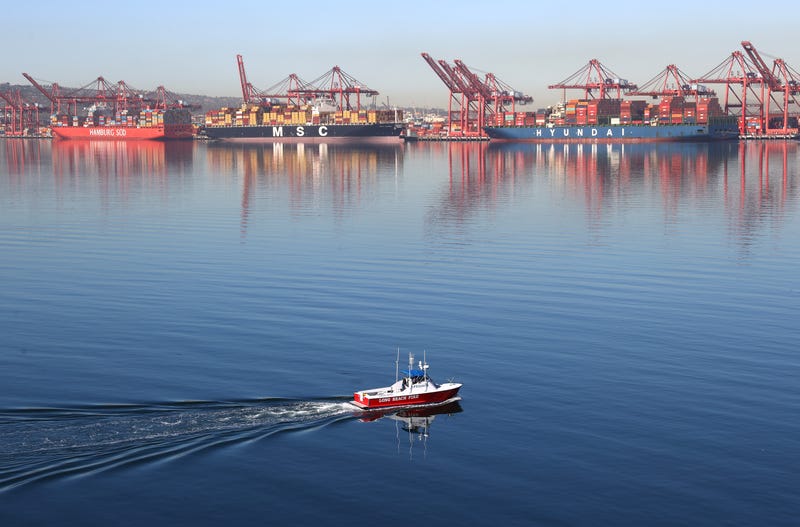
The Port of Long Beach continues to process cargo volumes at record-breaking levels topping 10 million twenty-foot equivalent units as of September, a first for the facility, despite earlier predictions of 10% to 35% loss of year-to-year cargo volumes due to federal trade policies, officials announced Friday.
Want to get caught up on what's happening in SoCal every weekday afternoon? Click to follow The L.A. Local wherever you get podcasts.
"At the time, I said that these concerns were certainly legitimate," Mario Cordeo, port CEO, said during a Friday media briefing on Zoom. "However, I also said, let's step a step back and see how the tariff policy conversations play out."
"Clearly, today, it's fair to say that the worst scenarios that some predicted did not occur," he added.
Dockworkers and terminal operators moved 839,671 TEUs of cargo containers in October, down 14.9% from October 2024. Imports declined 17.6% to 401,915 TEUs and exports decreased 11.5% to 99,817 TEUs. Empty containers moving through the port were down 12.6% to 337,940 TEUs.
The port moved 8,229,916 TEUs through October, up 4.1% from the same period last year.
Through the first nine months of 2025, the Twin San Pedro Bay Port Complex moved 15.2 million TEUs, representing a 4.9% increase compared to the same period in 2024.
For the Port of Long Beach, January and July were the busiest with approximately 952,733 TEUs and 944,232 TEUs processed during those two months respectively.
Cordero cited the port's success to lessons learned from the COVID-19 pandemic on how to manage disruptions and congestion.
The reason for the increase in cargo volume comes as many retailers and shippers front loaded in anticipation of tariffs, as well as pauses on tariffs seen earlier in the year, according to Cordero.
"We are anticipating a robust Black Friday, but consumers are likely to be a little more cautious with their spending this year due to rising prices -- this is reflected by a slight decline in the types of goods usually purchased as gift items," Cordero said.
For example, the port moved 98,000 TEUs filled with sweaters, coats and sweatshirts. That figure was down 52% from the same point last year. Additionally, the port moved 65,000 TEUs of refrigerators and other kitchen appliances, down 3.2% from 2024.
Toys and games from China filled 62,000 TEUs, a decline of 2.3% compared to figures in 2024.
"Rest assured, we are doing our part to ensure retailers keep the shelves stocked during the extraordinary time of consumer demand, and shoppers will be able to purchase their gifts for the holidays," Cordero said.
"We're looking forward to a moderate increase in cargo in 2026," he added. We are paying close attention to how our workforce and customers may be affected as trade policies continue to evolve.
Cordero warned that consumers may soon see price escalation in 2026 as shippers continue to pass along costs of tariffs on goods -- with a higher percentage to be passed on to the consumer. Some of those price increases in 2025 were shared between manufactures and retailers, protecting consumers to a certain extent.
Noel Hacegaba, the port's chief operating officer, emphasized that while the federal government is in the middle of the longest government shutdown, cargo continues to move smoothly through the port.
"We continue to coordinate closely with all of our partners to anticipate and mitigate issues before they arise to keep cargo and our economy moving," Hacegaba said.
Earlier this week, the U.S. Supreme Court weighed in on a closely watched case regarding President Donald Trump's so-called "reciprocal tariffs." Three of the court's liberal-leaning judges and three conservative ones raised questions about the president's power to impose tariffs.
Last week, the US and China reached an agreement following months of negotiations and threats of imposing more than 100% tariffs on goods.
The U.S. agreed to lower its tariff on goods from China about 10 percentage points (dropping from 30% down to 20%) and suspended any heightened reciprocal tariffs on China through Nov. 2026.
Meanwhile, China agreed to trade rare earths, ending controls the nation had placed on the materials.
White House officials also announced China would end various investigations into American companies in the chip industry. Additionally, China will suspend all retaliatory tariffs that were announced since March -- covering a variety of agriculture products like chicken, wheat, corn and other items.
China agreed to buy 12 million metric tons of American soybeans through the end of 2025, and purchase another 25 million tons for the next three years. China is expected to once again purchase U.S. sorghum and hardwood logs as well.
Hacegaba noted that negotiations between the U.S. and China impacted the agriculture industry.
"China has dropped to our number five destination for soybean exports with only 664 TEUs, which represents a 93% drop from last year," Hacegaba said. "We also saw a decline in soybean exports to Hong Kong from 3,700 TEUs between January and September 2024 to just about 240 TEUs during the same period in 2025 as trade policies shifted."
He added that China started purchasing soybeans from other countries, mainly in South America and principally Brazil.
Meanwhile, he highlighted that the port is advancing $3.2 billion in capital improvements over the next 10 years.
"Our largest project, the Pier B On-Dock Rail Support Facility continues construction, and we hope to start adding six new locomotive tracks next year," Hacegaba said. "The project is scheduled for completion in 2032."
Caltrans, the ports and cities of Long Beach and Los Angeles will be announcing new traffic routes and upcoming construction schedules in the future.
Follow KNX News 97.1 FM
Twitter | Facebook | Instagram | TikTok
